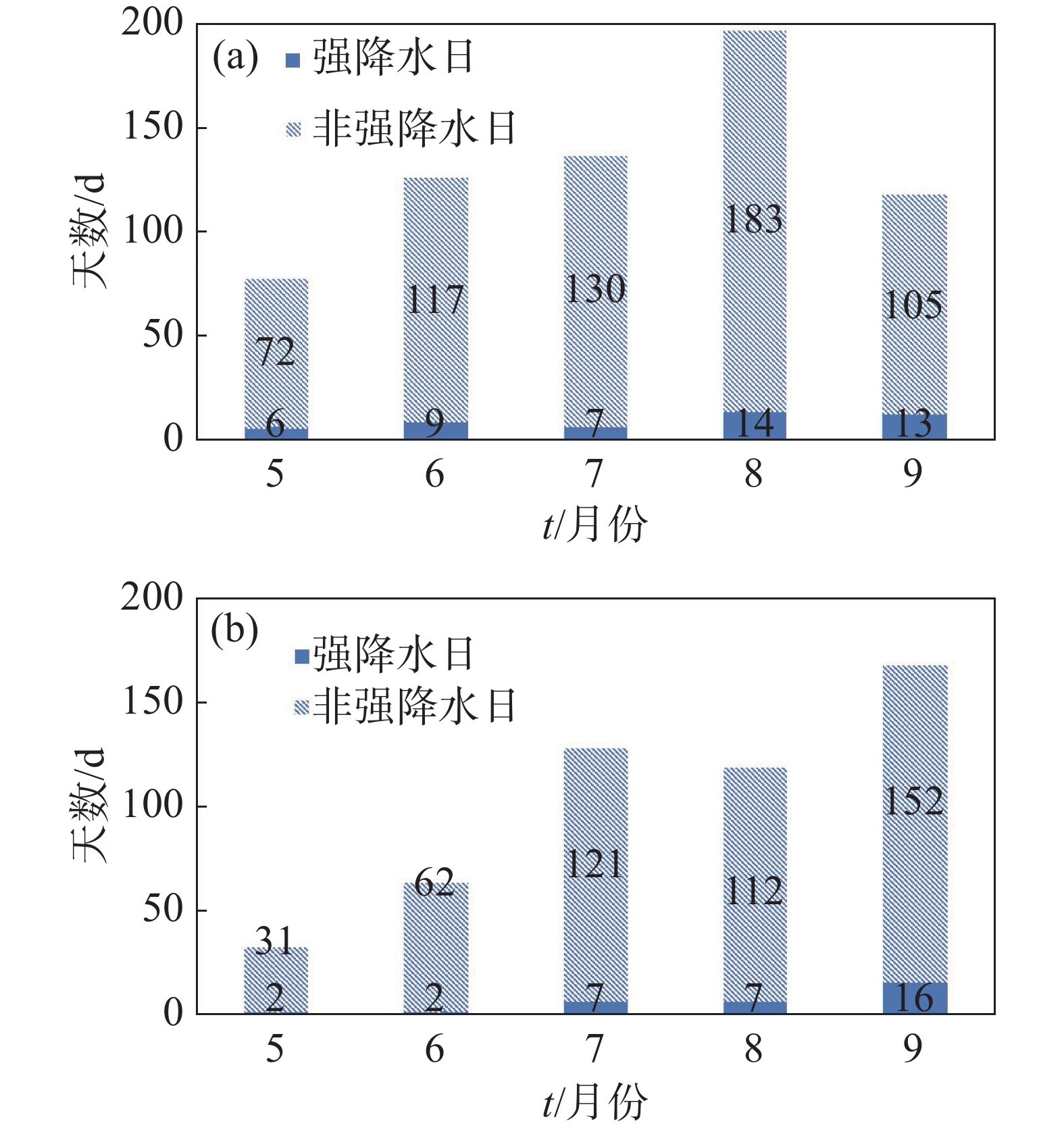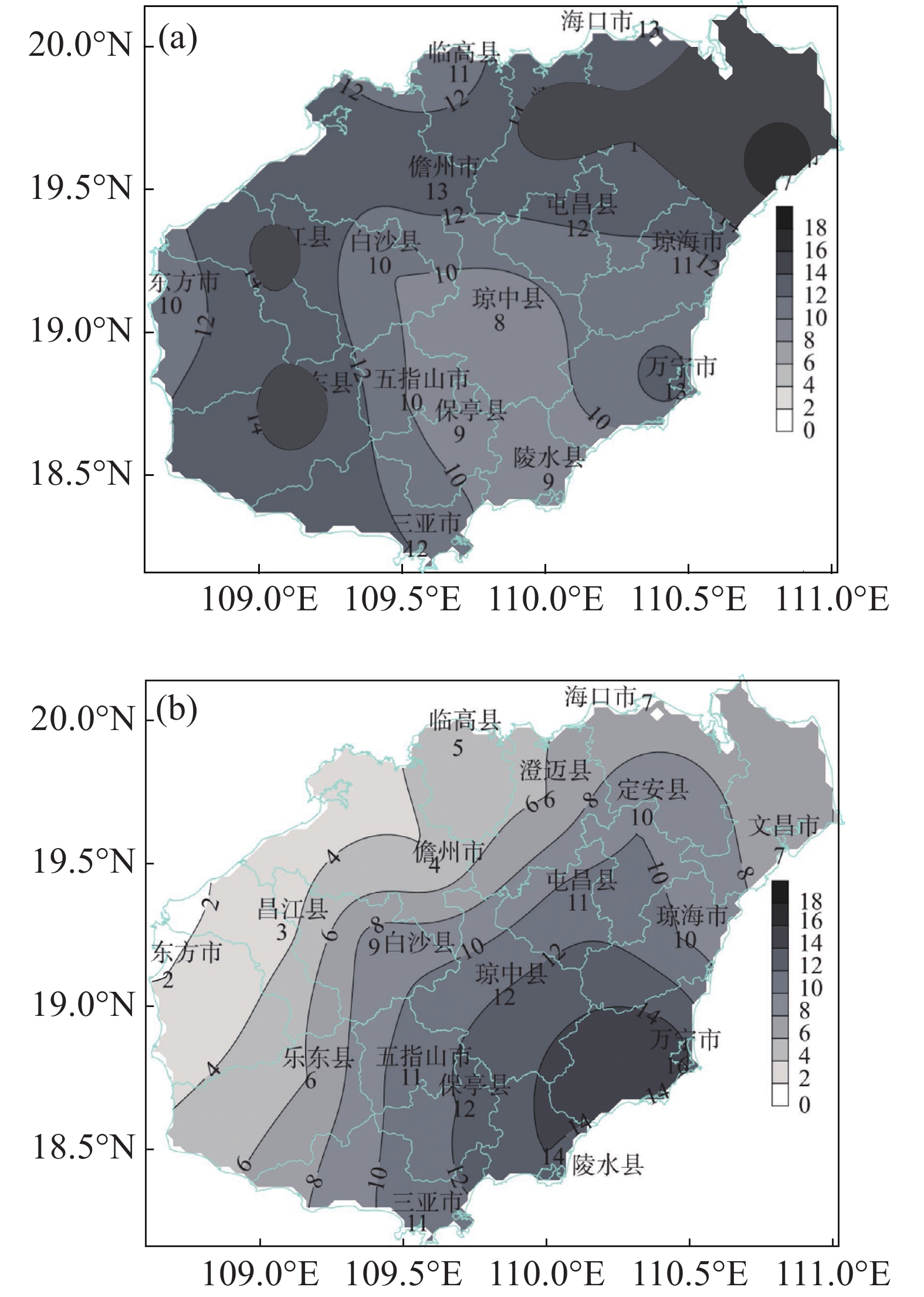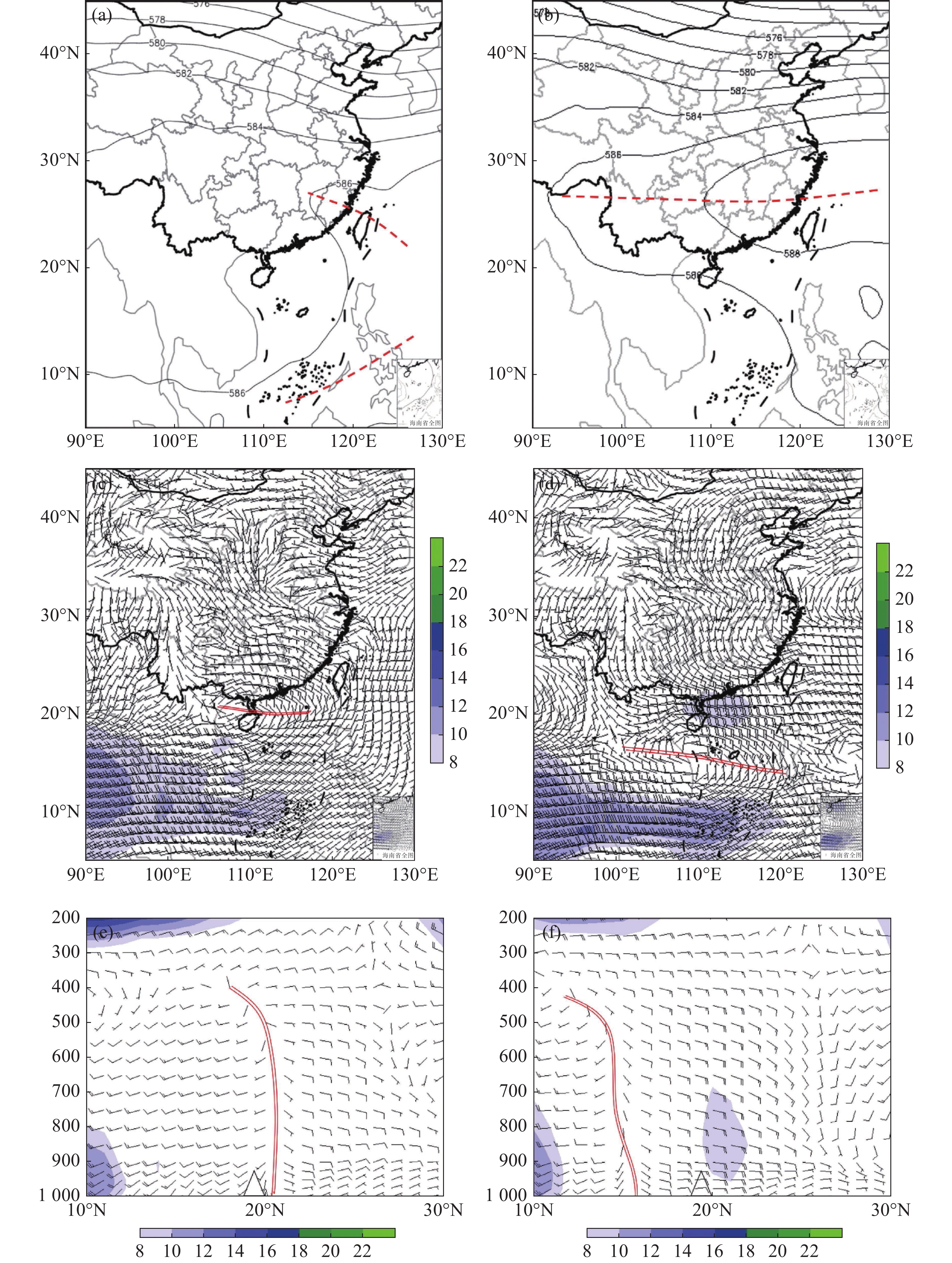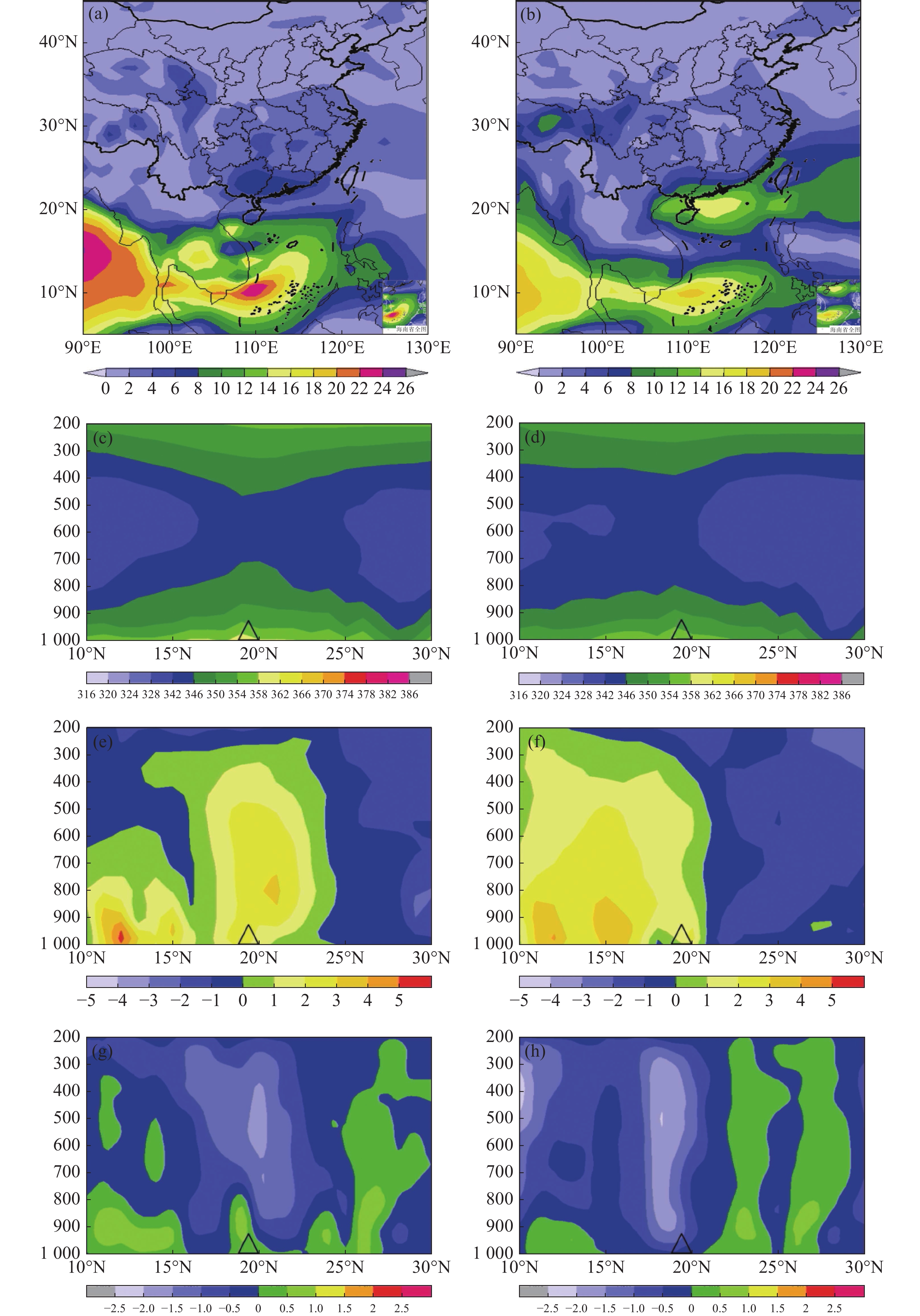-
西南夏季风影响期间,南海通常存在一条东西向气压较低的地带,被称为南海季风槽。由于季风槽是一个低压槽,所以低层大气向这个地带辐合, 进而产生降水, 因此也是降雨区所在之处[1]。潘静等[2]通过研究指出,亚洲夏季风槽低层辐合、高层辐散的配置特征很容易使低层的对流和上升运动得以建立和加强,因此季风槽成为除了热带气旋外汛期影响海南岛及南海的主要降水系统,影响频繁,往往带来大范围的降水天气,其中不乏暴雨,甚至大暴雨以上量级的降水。我国对南海季风槽的研究多偏向于气候和结构特征、维持机制、内部能量转换,以及季风槽对台风的发生、发展的作用等方面,如王黎娟等[3]指出南海季风槽在辐合和对流方面均比副热带夏季风槽更强;李崇银等[4]研究表明南海季风槽的强弱异常对中国夏季降水有重要影响;高建芸[5]、张翔[6]、黄荣辉等[7]研究了南海-西北太平洋季风槽年代际变化对热带气旋生成大尺度环境因子变化的影响及其机理。针对南海季风槽降水的研究也多局限于华南的两广一带地区,黄忠等[8]对广东后汛期季风槽暴雨天气形势特征进行分析;卢山等[9]对南海季风槽伴随热带气旋登陆华南而导致热带气旋暴雨增幅进行研究;纪忠萍等[10]研究得出6—8月广东3次季风槽暴雨从间歇-开始-旺盛-减弱-结束期的大气环流场演变特征;杨辉[1]、蒙伟光等[11]从单次暴雨入手,对暴雨发生期间季风槽气旋性涡度向上发展的机理及其对季风槽维持发展和中尺度对流系统活动的影响进行分析;陈见等[12]主要研究了两广一带的季风槽,发现相似的环流系统配置下,由于环流系统位置、强度及干湿特征的差异可导致降水出现明显差异。目前,针对季风槽在海南岛乃至整个南海产生的降水研究尚少。
一般来讲,随着南海季风爆发,南海地区季风槽的建立时间平均是5月第4候,维持到10 月份才出现明显的南撤,期间季风槽随着季风的进退而在南海及华南区域发生变化[2]。海南省约200万km2为海域面积,广阔的海洋不仅仅是南海夏季风爆发的源地,也是季风槽长时间活动的区域,据笔者统计,季风槽在南海年均活动58.4 d,因此,对季风槽降水的研究尤为重要。日常业务中,由于季风槽位置不同,给海南岛带来的降水有很大的差异,尤其是槽区分别位于海南岛上空附近和位于海南岛以南时,往往暴雨以上量级的降水落区差异较大。根据季风槽位置进行分类研究,也许可增进对南海季风槽天气气候特征的了解,尤其可提高对其强降水形成机制的认识,因此,本研究采用统计分析方法,将影响海南的南海季风槽按活动范围进行分类统计,并对强降水过程进行多样本合成分析其环流特征和降水机理,为海南季风槽暴雨预报提供参考。
-
在统计分析过程中主要使用了下列资料:
(1) 2001—2020年5−9月海南岛18个常规气象站日雨量观测资料,以北京时间08:00时为日界;
(2) NCEP每6 h(世界时间00:00时、06:00时、12:00时、18:00时)的位势高度、风、海平面气压等再分析资料,网格空间分辨率为1°×1°。
-
本研究所指季风槽为活动在中南半岛至南海区域的850 hPa 低气压槽,统计时按陈见等[12]相关研究中的标准进行,即南海季风槽区域:105°~120°E,5°~25°N;西南(或偏南)气流与东南(或偏东)气流构成风向风速切变,风切变两侧至少有1 个或以上格点风速≥8 m·s−1;生命史 48 h 以上。本研究参照《海南省气象局气象灾害预警发布业务规定》第五条“暴雨预警发布标准”中“暴雨四级预警”(最低级别)发布标准制定强降水日。标准内容为:“预计未来24 h内,本省3个及以上市县大部乡镇将出现50 mm以上降雨。”因海南省乡镇自动站2004年开始布设,近5年才布设完善,乡镇自动站资料存在不同步的问题,所以本研究将3个以上常规气象站日降水量≥50 mm自行定义为强降水日。
-
按引言所述,本研究根据季风槽位置将其划分两类:季风槽位于17°~21°N之间为Ⅰ类,即槽区位于海南岛(18°11′~20°10′N)上空附近;位于17°N以南为Ⅱ类,即槽区位于海南岛以南。再进一步对两类季风槽降水进行统计。
-
2001—2020年共20 a中,5—9月季风槽活动过程次数、天数,总过程次数、天数如表1,出现季风槽过程次数为205 次,年均出现10.3 次,天数为1 168 d,年均58.4 d,一次季风槽活动平均5.7 d。8月是过程次数和天数最多的月份,分别平均为2.7次和15.8 d,其次为9 月,7月居中,5月份最少。统计表明, 2011年季风槽活动过程达13次之多,为活动次数最多年份(图1-a),在活动天数方面,2014年以94 d为最多 (图1-b)。另外,从图1-b可见,季风槽活动的天数总体为递增趋势。
各月季风槽次数及天数 5月 6月 7月 8月 9月 5—9月合计 次 天/d 次 天/d 次 天/d 次 天/d 次 天/d 总次数 总天数/d 合计 25 111 37 190 42 265 54 316 47 286 205 1168 年平均 1.3 5.6 1.9 9.5 2.1 13.3 2.7 15.8 2.4 14.3 10.3 58.4 在20 a季风槽活动的1 168 d中,强降水日为83 d,表明以季风槽活动为背景的形势下,海南岛产生强降水的占比为7.1%。分类来看,Ⅰ类季风槽和Ⅱ类季风槽的活动天数分别为656 d和512 d,其中,Ⅰ类季风槽产生强降水的天数为49 d,占强降水总天数的59%,占季风槽活动天数的4.2%,占Ⅰ类季风槽活动天数的7.5%;Ⅱ类季风槽产生强降水的天数34 d,占强降水总天数的41%,占季风槽活动天数的2.9%,占Ⅱ类季风槽活动天数的6.6%。相对来说,当Ⅰ类季风槽活动时,发生强降水的占比比Ⅱ类大。从月分布可知,季风槽强降水天数逐月递增,5月仅8 d,而8月和9月递增到21 d和29 d,但两类季风槽具体情况各不相同。Ⅰ类季风槽活动天数8月最多,为197 d,但从产生强降水的占比来看,9月11.0%最高,7月 5.1%最低,也就是说,Ⅰ类季风槽在8月最为活跃,9月最易产生强降水(图2-a);Ⅱ类季风槽最活跃和强降水占比最高的月份均为9月,9月的活动总天数为168 d,其中16天为强降水日,占比9.5%,而6月强降水日占比最少仅为3.1%。另外,5−8月,Ⅰ类季风槽均比Ⅱ类季风槽活跃,而9月Ⅱ类季风槽明显活跃于Ⅰ类。
-
Ⅰ类季风槽过程海南岛强降水暴雨频次分布,东北部和西南部地区为高频区,其中文昌出现频次最高,达到17次;中部地区频次最低(图3-a)。Ⅱ类季风槽过程海南岛强降水暴雨的频次分布与Ⅰ类存在明显差别,呈自东南向西北方向递减的明显特征,东南部为最高值区,西部沿海为最低值区,其中万宁出现频次最高,为16次,东方频次最低,仅为2次(图3-b)。
两类降水日平均雨量分布与频次分布相似,Ⅰ类最大值出现在东北部的文昌,为92.8 mm,Ⅱ类东南部的陵水日平均雨量最大,达到117.1 mm。在逐日的单站降水中,两类降水达到大暴雨(大于等于100 mm,小于250 mm)及以上量级的站次均约占22%,Ⅰ类以文昌6次为最多,Ⅱ类的陵水与万宁并列6次为最多,但达特大暴雨(大于等于250 mm)量级的仅出现在Ⅱ类的陵水,2002−09−19降水量达351.7 mm,由此可见Ⅱ类东南部更容易出现极端降水。
-
为了更好的体现每一类季风槽的共性和特征,在此,分别将前文统计筛查出的Ⅰ类(49 d)和Ⅱ类(34 d)强降水日利用NCEP再分析资料计算其平均环流场,分别考察其环流合成特征,分析表明,2种类型产生强降水的主要影响天气系统,除季风槽外,还有西太平洋副热带高压(以下简称副高)、低空急流和倒槽等,系统的强度和空间位置分布上有相似之处,也有差异和不同,因此,将两类季风槽分别进行讨论分析并总结其异同点,希望能为海南岛的季风槽降水研究及预报提供一定的线索。
-
500 hPa高度场(图4-a),东亚有西风槽活动,槽底位于华东地区,东亚槽引导低层冷空气从东路向华南东部和南海东北部扩散。从图4-a可知,副高主体偏东位于西太平洋洋面上,呈类似双脊线形态,北侧弱脊线由26°N向江南伸展,平均586 dagpm线西脊点位于江西中南部地区,即115°E附近;南侧脊线则在15°N以南向南海南部伸展,586 dagpm线西脊点在110°E以西。逐个个例来看,副高脊线位置分化为南北两种,这也是平均图呈现类似双脊线的主要原因,而且副高强度整体偏弱,因此平均图未出现表征副高主体强度的588 dagpm线。从图4-a同时可看出,南海北部存在宽广的低槽区,可见季风槽在500 hPa上也有明确体现。
850 hPa风场体现了季风槽的位置。Ⅰ类季风槽平均切变线位于20°N,即海南岛北部沿海到南海北部一带,且北部湾北部有气旋式环流,对应的海平面气压场在北部湾到雷州半岛一带有低压中心,可见季风槽偏强,普遍存在扰动,但并未形成热带气旋(热带气旋直接影响的个例已经剔除),而海南岛东北部地区位于切变线南侧、气旋性环流东侧,有明显的风向和风速辐合。孟加拉湾到南海南部的偏西气流,风速基本在8~12 m.s−1之间,从孟加拉湾到切变南侧风速明显辐合(图4-c)。平均场有平滑作用,因此体现的风速偏小,在单个个例中季风往往存在12 m.s−1以上的急流带。海南岛上空沿110°E的风场剖面图体现了季风槽的伸展高度可达500~400 hPa(图4-e),与500 hPa高度场平均图对应,另外,低层风场由低纬向海南岛有风速辐合。低层风场的配置非常有利于季风将水汽和能量向海南岛输送并产生辐合,其中东北部地区辐合条件更好。850 hPa风场和海平面气压场体现了冷空气主体偏弱偏北,对海南岛无直接影响,但冷空气使得季风槽北侧气压梯度增大,偏东气流也增大,季风槽风速切变加大,强度得以增强或维持[5]。同时,高层南亚高压较强盛,且200 hPa流场图(图略)上季风槽上空受南亚高压东南侧的东到东北气流所控制,并出现风速辐散。Ⅰ类季风槽为典型的低层辐合、高层辐散配置,从大尺度环流场上给强降水提供了有利条件。
海南岛地处低纬热带,且海岛中央山地高耸四周低,属于钟形地形,一方面由于海陆温差有利于海陆风的发展,另一方面迎风坡具有降水增幅作用。张振州[13]和邱晓暖等[14]研究指出对于夏季盛行偏南到西南风的海南岛来说,中午到傍晚海南岛东北部更容易形成海陆风辐合带;海陆风辐合带又因其存在强烈的上升运动而成为暴雨等强对流天气的触发机制。Ⅰ类季风槽影响期间,海南岛低层受西南风影响,与夏季主要风场一致,因此海南岛东北部更容易因海陆风作用发生暴雨。另外,钟形地形的迎风坡对降水具有增幅作用[15]。对于西南气流而言,海南岛西南部为迎风坡,中午到傍晚在海风效应的叠加作用下,西南部地区低空背景西南风相对增大,地形抬升随之相应增强,从而使降水加强。可见,暴雨出现频次偏高的区域(海南岛东北部和西南部地区),除了和辐合带的结构紧密相关,地形也起到了一定的作用。
-
Ⅱ类西风槽平均位于华北地区,而副高偏强,呈带状分布,脊线平均位于26°N附近,这也和此类暴雨多出现在9月(占47%)比较吻合,586 dagpm线西脊点比Ⅰ类明显偏西,伸至92°E附近(图4-b),强大的带状副高阻断水汽向北输送,以及西风槽引导冷空气向南扩散,均有利于季风槽水汽和北侧偏东气流的增强。
850 hPa风场上15°N附近为低槽区,并在110°E有气旋式环流存在,孟加拉湾到南海南部的偏西风风速也普遍在8~12 m·s−1,其中12 m·s−1急流较Ⅰ类范围更广,表明季风更加强盛。对应气旋式环流,海平面气压场同样有低压中心,而且华北到江南地区有冷高压,北高南低的形势场使得南海北部气压梯度增大,从而加强了季风槽北侧、即南海北部的东-东南气流,这支气流以6~10 m·s−1为主,其中在北部湾东部到海南岛西部沿海一带有倒槽,倒槽以东19°~22°N之间南海西北部到北部湾北部有相对的大风速带(8~10 m·s−1),海南岛位于季风槽北侧,因此受倒槽及强的东-东南气流影响(图4-d)。同样的,逐个个例来看,Ⅱ类季风槽北侧低层普遍存在风速大于12 m·s−1的东-东南急流,海南岛位于急流出口区左侧。风场剖面季风槽的伸展高度同样到达500~400 hPa(图4-f),海南岛北侧低层为东-东南风强风速中心,即海南岛位于低层风轴的左侧。200 hPa上,海南岛也处于南亚高压东南侧的风速辐散场中。
低空急流是一种动量、热量和水汽的高度集中带,它对强天气的作用主要有通过低层暖湿平流的输送产生位势不稳定层结;在急流出口处有明显的水汽辐合和质量辐合或强上升运动;在急流轴的左前方是正切变涡度区,有利于对流活动发生[16]。由此可见,对于Ⅱ类季风槽强降水来说,水汽和能量输送,以及动力抬升主要来源于偏东急流。
对于东-东南气流而言,海南岛东部和东南部地区受地形阻挡抬升,导致迎风坡和背风坡雨量分布出现不同,呈自东南向西北方向递减的明显特征。在各种地形中,迎风坡的喇叭口最有利于暴雨增强,原因在于,除了地形的抬升作用,环境风沿地形向喇叭口内部输送形成强的辐合上升区,进一步促进暴雨的发生,因此,在相同的形势场下,降水量呈现出由平原—山前—迎风坡—喇叭口显著增加的特征[17-18]。海南东部和东南部地区分别存在向东和东南方向开口的喇叭口,其中东南部陵水的喇叭口形状更加明显,有助于陵水产生极端降水。同样,中午到傍晚海风叠加环境风,低空东-东南风增大,从而增强了地形作用,使降水进一步加强。在夜间,海南岛往往陆风效应明显,即由内陆向周围海洋吹陆风,其中东南部地区极易形成西北风与东南风的中尺度辐合线,触发强降水[13,19-21]。因此,Ⅱ类季风槽过程中,地形作用及其重要,暴雨高频区和极端降水区与迎风坡、喇叭口高度重合。
-
对比两类季风槽环流特征,Ⅰ类和Ⅱ类季风槽强度均偏强,其中存在低压环流,季风槽伸展高度均可达500~400 hPa,低层南侧季风输送强盛;高层均位于南亚高压东南侧,有风速辐散。
两类季风槽的不同点和季风槽与暴雨高频区的关系主要表现在以下几方面:(1)副高形态和强度不同。Ⅰ类副高主体偏东,脊线多样化;Ⅱ类副高为强盛的带状。(2)低层风场Ⅱ类季风槽南北两侧的风速明显强于Ⅰ类,其中北侧急流更为突出。(3)Ⅰ类强降水的发生与季风槽切变线位置、结构密切相关,暴雨高频区位于切变线南侧、气旋式环流东侧;Ⅱ类则与季风槽北侧低空急流、倒槽有关,暴雨高频区位于急流左前侧出口区。(4)两类季风槽地形的作用均与降水强弱分布有很好的对应,但由于低层背景风不同,二者存在明显差别,Ⅰ类低层背景风为西南风,地形作用分别增强了东北部和西南部地区的降水;Ⅱ类背景风为东-东南风,地形作用主要体现在东部和东南部地区,其中喇叭口地形作用突出。
-
孟加拉湾和南海中低层水汽向切变线附近有很好的输送,尤其是925 hPa,孟加拉湾水汽通量普遍大于20 g·cm−1·hPa−1,南海则大于12 g·cm−1·hPa−1,并存在大于20 g·cm−1·hPa−1的大值区(图5-a),而且由于低层辐合,水汽在海南岛也产生了辐合,尤其在海南岛的西南部和东北部地区(图略),在切变线北侧也有一条弱的水汽输送带,海南岛上空的整层大气水汽总量达到70~80 mm,可见这类型降水的水汽条件非常好。另外,从假相当位温的垂直剖面图(图5-c)可以看到,12°~27°N之间850 hPa以下为高能区,海南岛边界层出现了358~362 K的中心,并以海南岛为中心高能舌向上伸展,346 K伸展至700 hPa,为暴雨的发生提供了大量不稳定能量。低层假相当位温图可见弱冷空气向南海东北部和华南南部扩散,有利于季风槽加强。季风急流从低纬度向海南岛输送强盛的暖湿气流,并在海南岛形成辐合和堆积,给强降水提供了充沛的水汽条件和不稳定能量。
由于季风槽具有强辐合性的特点,所以涡度也是反映季风槽强弱的一个很好的指数[2]。图5-e显示,季风槽槽区(约17°~24°N之间)300 hPa 以下均为正涡度区,20°N上空(即切变线所在位置)有明显的柱状高值区,涡度中心值在3~4·10−5s−1之间,海南岛上空为2~3·10−5s−1,而产生一般降水的季风槽剖面中槽区正涡度中心(0~1·10−5s−1)明显弱于强降水,且伸展高度(400 hPa)也低于强降水,可见产生强降水的季风槽明显偏强。500 hPa、850 hPa和925 hPa的涡度平面图上,涡度大值区与切变线的位置比较契合,海洋比陆地更强,在北部湾和雷州半岛以东分别有强中心存在,与环流场气旋性环流和环流东侧风向辐合区相匹配;垂直速度的剖面图同样体现了季风槽的上升运动,海南岛上空,也就是季风槽切变线南侧的位置,800 hPa以下有弱的下沉运动,而800 hPa以上均为上升气流(图5-g)。从以上结果可以看出,此类季风槽强盛,从高层负涡度、低层正涡度的配置,以及垂直速度来看,它都具备了较强的降水动力条件。850 hPa散度场也表明,低压环流东侧、切变线南侧有辐合中心,辐合中心覆盖了海南岛东北部。
因此,结合环流特征分析,此类降水的动力条件直接来自季风槽的抬升,从高低空配置来看,季风槽低层辐合、高层辐散,这种配置特征很容易使低层的对流和上升运动得以建立和加强。季风槽南侧从孟加拉湾到南海深厚的西南季风,向其输送海洋性暖湿气流,给降水提供了充沛的水汽及能量。预报Ⅰ类季风槽降水,需关注季风和季风槽槽区的变化,如果季风增强并在孟加拉湾到南海中南部海域出现西南风急流带,且季风槽槽区切变增强,往往造成海南岛强降水的发生。在考虑强降水落区时,需进一步关注季风槽切变线和其中气旋性环流的位置,同时考虑海陆风和迎风坡的作用。
-
环流分析已知Ⅱ类季风槽强降水与低空急流有直接关系,由于低空急流不仅能把低层水汽、热量集中往下游输送,使下游地区造成或增大位势不稳定,且能在其左前方范围内造成强烈的辐合上升运动,特别是如果在急流左侧有很强的切变正涡度时,则更有利于产生强上升运动[21-22],在此笔者进一步分析强降水的各项条件。由于副高的阻断和南海北部东-东南急流的存在,季风槽北侧存在一条大于8 g·cm−1·hPa−1的水汽输送带从巴士海峡以东一直向西延伸到越南北部(图5-b),并在南海北部出现14~16 g·cm−1·hPa−1的中心,位于急流的左前侧及倒槽的东侧,具有比较好的辐合条件。因此,在良好的水汽输送下,海南岛上空整层大气水汽总量达60~80 mm,给降水提供了充足的水汽条件。从假相当位温的垂直剖面图(图5-d)可以看到,12°~27°N之间900 hPa以下为高能区,海南岛边界层中心值为354~358 K,上空346 K伸展至800 hPa附近,急流输送的暖湿空气使得海南岛低层聚集了较强的不稳定能量。相比而言,Ⅱ类东-东南急流输送的不稳定能量略弱于Ⅰ类西南季风的输送。
由于Ⅱ类季风槽位置偏南,涡度垂直剖面图的强中心位置也偏南(图5-f),海南岛上空的正涡度为1~2·10−5s−1,虽弱于Ⅰ类,但同样伸展至300 hPa附近,另外,在急流轴的左前方也是正切变涡度区,因此,海南岛上空的正涡度区不仅取决于季风槽,也取决于低空急流和倒槽。在急流最大风速中心的前方有明显的水汽辐合和质量辐合或强上升运动[16],图5-h中也体现了海南岛上空整层为上升气流,其速度值主要在−0.15~−0.2 m·s−1之间。
结合环流特征分析,Ⅱ类季风槽由低空东-东南急流起着输送低空大气的热量、水汽和动量的作用,从而产生强降水。预报Ⅱ类季风槽降水,除了关注季风槽的加强,还要关注北高南低的形势是否造成南海北部低层东-东南气流的加强而出现急流,海南岛是否位于急流出口区左侧。Ⅱ类降水在不稳定能量及大尺度动力条件方面弱于Ⅰ类的情况下,东南部地区却更容易产生极端降水,喇叭口地形的作用不可忽视。
-
在2001—2020年的5—9月中,南海季风槽活动总天数为1 168 d,年均出现10.3 次季风槽过程,年均58.4 d,1次过程平均5.7 d。8月是过程次数和天数最多的月份,其次为9 月,5月份最少;5—8月,Ⅰ类季风槽均比Ⅱ类活跃,而9月Ⅱ类则更活跃。海南岛共出现83 d强降水(即3个以上常规气象站暴雨),占季风槽活动天数的7.1%,5—8月强降水天数呈逐月递增,其中Ⅰ类发生强降水的占比大于Ⅱ类。Ⅰ类季风槽在8月最活跃,9月最易产生强降水;Ⅱ类季风槽最活跃和强降水占比最高的月份均为9月。Ⅰ类强降水暴雨频次分布以东北部和西南部地区为高频区,中部地区频次最低,Ⅱ类则以东南部为高频区,并向西北方向递减。两类降水日平均雨量分布与频次分布相似,而Ⅱ类东南部更容易出现极端降水。
高层南亚高压的辐散作用、中低层强盛的季风和季风槽是发生强降水的前提,但季风槽位置不同导致影响降水的系统配置有区别。Ⅰ类强降水的发生与季风槽切变线位置、结构密切相关,季风将水汽和能量向槽区输送,季风槽低层辐合、高层辐散的配置特征使低层的对流和上升运动得以建立和加强从而产生降水,暴雨高频区与切变线南侧、气旋式环流东侧辐合条件最强的区域对应;Ⅱ类则与季风槽北侧低空急流有关,低层水汽和能量通过低空急流向位于急流左前方的海南岛输送,并在海南岛产生强烈的辐合上升运动,导致强降水发生,暴雨高频区与急流左前侧出口区有很好的对应关系。
降水强弱分布与海南岛钟状特殊地形结构紧密相关,两类季风槽暴雨高频区均与地形强作用区有很好的对应,但由于低层背景风不同,二者存在明显差别。Ⅰ类低层背景风为西南风,地形作用分别增强了东北部和西南部地区的降水;Ⅱ类背景风为东-东南风,地形作用主要体现在东部和东南部地区,其中喇叭口地形作用突出。
Analysis of the characteristics of two different types of monsoon trough and mechanisms of heavy rainfall over Hainan Island
doi: 10.15886/j.cnki.rdswxb.2022.04.005
- Received Date: 2021-09-15
- Accepted Date: 2022-05-09
- Rev Recd Date: 2022-05-06
- Available Online: 2022-06-10
- Publish Date: 2022-07-26
-
Key words:
- monsoon trough /
- heavy rainfall /
- circulation pattern /
- low-level jet stream
Abstract: The spatial and temporal distribution characteristics for South China Sea monsoon trough activities and heavy rainfall between May to September from 2001 to 2020 Hainan Island were statistically analyzed by using NCEP reanalysis and land-based observations in Hainan Island. Monsoon trough that generates heavy rainfall events were grouped into two types according to its position. The composite analysis of high- and low-level circulations and their element fields were performed. The results show that the monsoon trough affecting Hainan occurred about 10.3 times per year on average, 58.4 days per year, and 5.7 days per event on average. The heavy rainfall events accounted for 7.1%, mainly occurring in August and September. The first type of monsoon trough was mostly active in August, and was the easiest to bring heavy rainfall in September. The second type of monsoon trough was mostly active in September and brought heavy rainfall most frequently in September as well. The high frequency heavy rainfall zones generated from the first and second types of monsoon trough were different, and the second type of monsoon trough tended to bring heavy rainfall more easily. The divergence of the high-level South Asia high, and strong monsoon and monsoon trough on moderately low level were a prerequisite for the occurrence of heavy rainfall, but establishment of monsoon trough at different locations led to different system configurations of rainfall. The occurrence of heavy rainfall in the first type of monsoon trough was highly related to the structure and shear line location of monsoon trough. The monsoon transferred the water vapor and energy to the trough zone, and the convergence on the low level and the divergence on the high level of monsoon trough generated and enhanced the convection and ascending motion on low level, which led to heavy rainfall. The high frequency heavy rainfall area in the first type of monsoon trough corresponded to the strongest convergence area on the south of the trough and the right side of cyclone circulation. The occurrence of heavy rainfall in the second type of monsoon trough was related to the low-level jetstream on the north side of monsoon trough and the water vapor and energy on low level were transferred by low-level jet to Hainan Island and resulted in the intense convergence upward motion over the island, which led to the occurrence of heavy rainfall. The intensity distribution of rainfall was also highly related with the special bell-shaped terrain of Hainan Island. The high frequency heavy rainfall areas in the two types of monsoon trough were both well corresponding to the strong terrain effect area, but were obviously different due to the different low wind background on low level.
| Citation: | CHEN Hong, GUO Dongyan, WU Yu, LI Xun. Analysis of the characteristics of two different types of monsoon trough and mechanisms of heavy rainfall over Hainan Island[J]. Journal of Tropical Biology, 2022, 13(4): 348-357. doi: 10.15886/j.cnki.rdswxb.2022.04.005 |


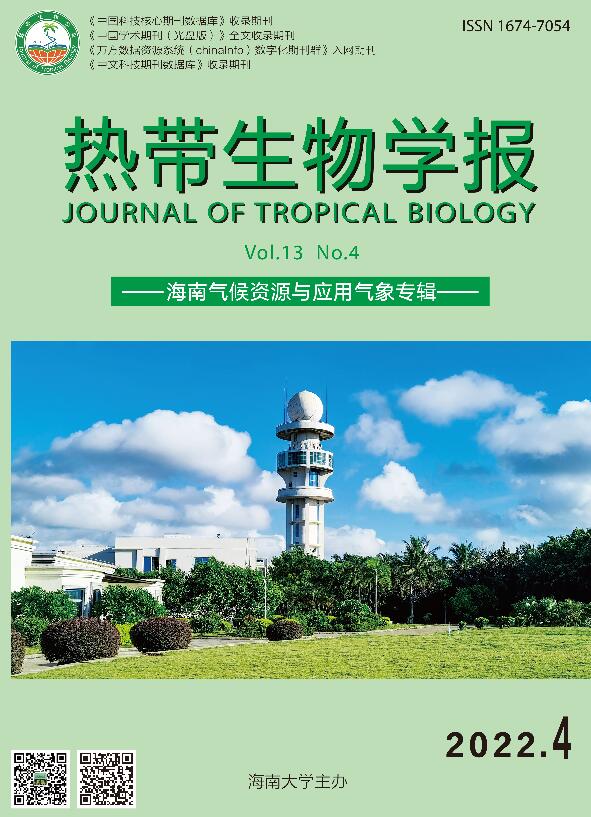


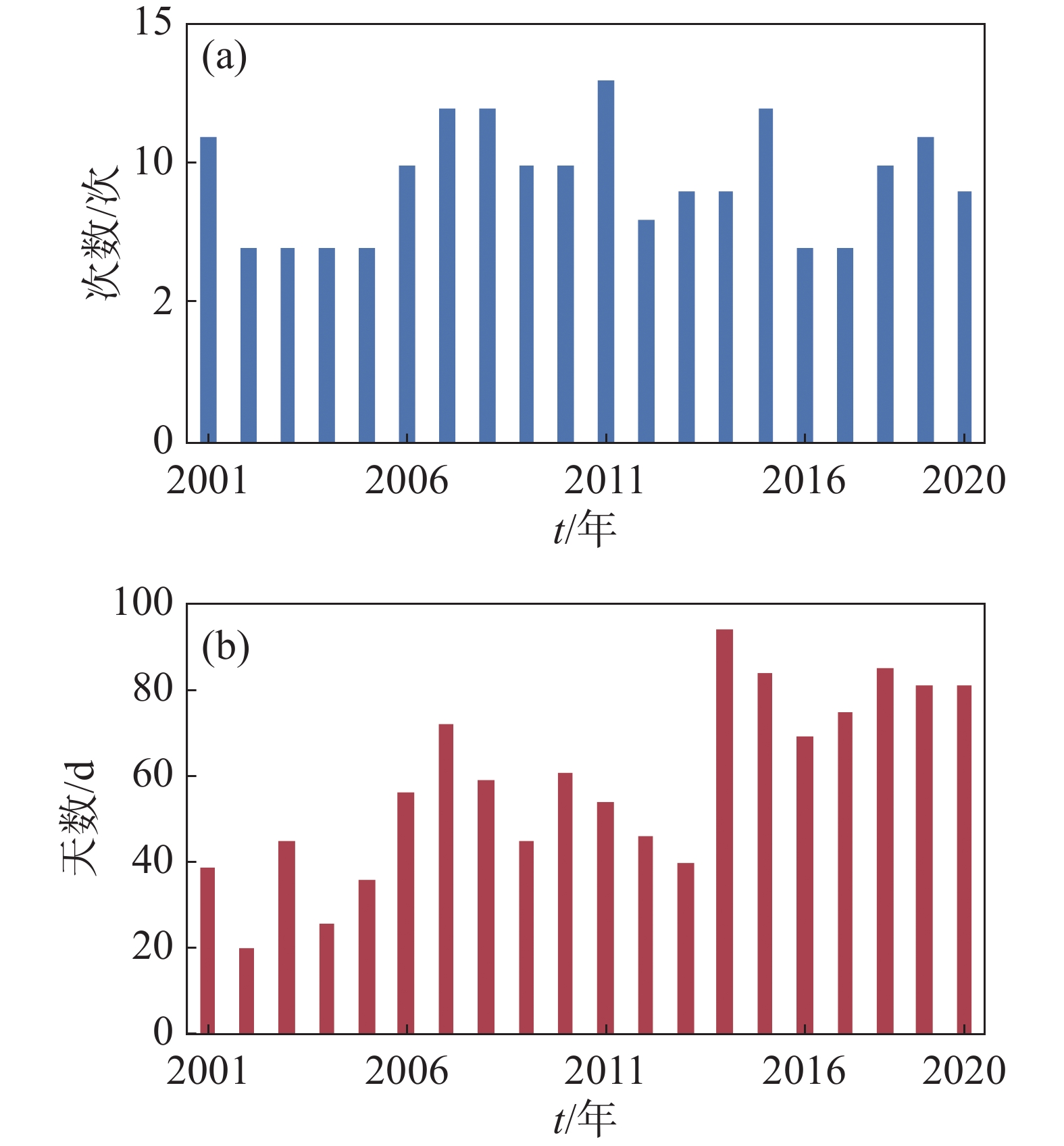






 DownLoad:
DownLoad:
